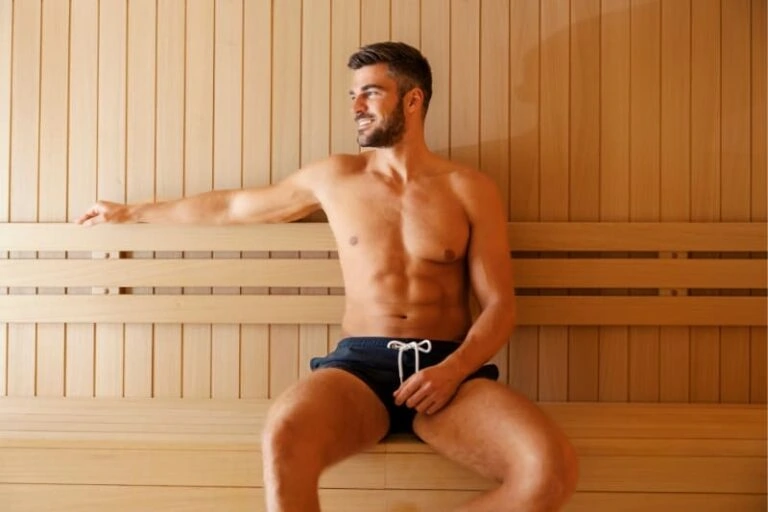Why Am I Not Sweating in the Sauna? 9 Science-Based Reasons

Key Takeaways
- Dehydration is the primary reason most people don’t sweat in saunas
- Higher body fat percentage reduces sweating efficiency by insulating heat
- Certain medications like antipsychotics and beta-blockers block sweat gland activation
- Poor electrolyte balance prevents effective sweat production
- Low fitness levels lead to delayed and reduced sweating response
- Regular sauna use improves sweating efficiency
Picture this: You’re sitting in a hot sauna, and while everyone around you is dripping with sweat, you’re surprisingly dry. If this sounds familiar, you’re not alone.
Recent studies show that many people struggle with this exact issue, and there’s usually a scientific explanation behind it.
In this article, we’ll discover the science behind sauna sweating, why you might not be sweating, and expert solutions to enhance your sauna experience.
| Medical Disclaimer The information provided in this article is for educational purposes only and is not intended as medical advice. Always consult with a qualified healthcare professional before starting any new health regimen, including the use of saunas. The author and publisher of this content are not responsible for any adverse effects or consequences resulting from the use of any suggestions, preparations, or procedures described in this article. |
Table of Contents
The Science Behind Sweating
Your body’s sweating mechanism is like a sophisticated cooling system. When your core temperature rises, specialized sensors trigger your sweat glands through a complex process called thermoregulation.
The sweating process involves several key components:
- Two main types of sweat glands: eccrine and apocrine
- Neural signals that trigger sweat production
- Blood vessels that supply necessary fluids
- Electrolytes that enable proper gland function
Your blood circulation plays a vital role too. Better circulation means more efficient delivery of fluids to your sweat glands, leading to more effective sweating.

Why Am I Not Sweating in the Sauna?
1. Core Reasons
a) Physiological Factors: The Big Three
1. Dehydration: Studies confirm that dehydration significantly impacts your ability to sweat. When you’re dehydrated, your body conserves water by reducing sweat production. Think of it as your body’s emergency water-saving mode.
2. Poor Electrolyte balance: Poor electrolyte balance prevents effective sweat production. Here’s how different electrolytes affect your sweating:
- Sodium: Controls fluid balance and sweat production
- Potassium: Essential for muscle function in sweat glands
- Calcium: Enables proper nerve signaling
- Magnesium: Supports overall gland function
3. Body Composition: Body composition variations directly impact sweating efficiency. Studies show that:
Higher muscle mass leads to:
- More efficient sweating
- Better heat regulation
- Quicker sweating response
While higher body fat causes:
- Slower heat dissipation
- Reduced sweating efficiency
- Greater heat retention
b) Medical factors: Medications and Health Conditions
Medications can dramatically affect your sweating ability. Clinical studies reveal that certain medications impact sweat production:
- Antipsychotics: Medications such as olanzapine and levomepromazine can impair the body’s ability to sweat by blocking muscarinic receptors, which are involved in sweat gland activation.
- Beta-blockers: Beta-blockers can affect blood vessel dilation and fluid balance, potentially impairing thermoregulation and reducing the effectiveness of sweating in hot environments.
- Diuretics: Diuretics promote fluid loss through increased urination, which can lead to dehydration. This dehydration can inhibit the body’s ability to sweat effectively.
Certain health conditions can significantly alter normal sweating patterns. Anhidrosis, for example, is a condition where the body fails to produce sweat adequately, which can be exacerbated by specific medications.
2. The Role of Fitness and Heat Adaptation
Studies demonstrate that your fitness level dramatically impacts how effectively you sweat in a sauna. When you’re not in good cardiovascular shape, your body struggles with:
- Delayed sweat response – taking longer to start sweating
- Reduced sweat production due to poor circulation
- Inefficient heat distribution throughout your body
- Trouble maintaining a stable temperature
Studies also show that lack of heat adaptation plays a role. If you’re new to saunas or use them irregularly, your body hasn’t developed proper heat responses, meaning higher temperatures are needed to trigger sweating.
Think of it like a rusty air conditioning system – without regular use and maintenance (exercise and consistent sauna use), it simply won’t kick in when it should.

3. Sauna Environment Factors
Not all saunas create equal sweating conditions. Traditional Finnish saunas operate differently from infrared ones, and each affects your body’s sweating response uniquely.
For optimal sweating, sauna temperature and humidity levels matter significantly. Here’s what experts recommend:
Traditional Sauna:
- Temperature: 160-200°F (71-93°C)
- Humidity: 10-20%
- Duration: 15-20 minutes per session
- Temperature: 120-140°F (49-60°C)
- Lower humidity requirements
- Sessions can last 20-30 minutes
Factors like proper sauna ventilation and seating position can also impact your sweating response. For example, the higher you sit in a traditional sauna, the more intense the heat exposure becomes.
4. Individual Variations in Sweating
Genetics plays a bigger role in sweating than most people realize. Research indicates that sweat gland density and function vary significantly between individuals. Some people naturally have higher sweat gland counts, while others have fewer active glands.
Age and gender create notable differences in sweating patterns:
Men typically:
- Have higher sweat rates
- Begin sweating at lower temperatures
- Produce more sweat per gland
Women often:
- Have more sweat glands overall
- Show different sweating patterns during hormonal changes
- May need longer to start sweating
When Your Sauna Sessions Need Medical Attention
Look, I get it – not sweating in a sauna might seem like just an annoyance. But sometimes, it’s your body waving a red flag. Let me share what medical experts say about when to take this seriously.
Red Alert Symptoms You Can’t Ignore
Ever sat in a sauna and felt something wasn’t quite right? Certain symptoms need immediate attention. I’m talking about:
- Zero sweating despite sitting in high heat – this isn’t normal
- Getting dizzy or confused – your body’s screaming for help
- Your heart racing unusually fast
- Feeling weirdly tired or weak when you shouldn’t be
If you hit any of these symptoms, get out of the sauna immediately and cool down. Your safety comes first.

When to Book That Doctor’s Appointment
You don’t need to panic over every sweating quirk, but some patterns deserve professional attention. Keep an eye out if you notice:
- You consistently can’t sweat, no matter what you try
- The heat feels unbearable when it didn’t before
- Your sweating patterns have changed for no obvious reason
- New medications are affecting your sauna experience
Got These Conditions? Extra Caution Required
Some health conditions need special consideration. If you’re dealing with:
- Heart issues
- Diabetes
- Thyroid problems
- Blood pressure concerns
Here’s the deal – chat with your doctor before hitting the sauna. They can give you personalized guidelines that keep you safe while still enjoying the benefits.
Remember, being smart about sauna safety isn’t being paranoid – it’s protecting your health. Most sweating issues have simple fixes, but knowing when to get medical help makes all the difference.
Sauna Sweating Tips: Proven Methods to Enhance Your Response
Want to improve your sauna sweating response? Proper preparation makes the biggest difference. Let me share the most effective methods I’ve found backed by science.
1. Smart Hydration Strategy
Your sweating ability starts with proper fluid balance. Here’s your sauna hydration game plan:
- 16-20 oz water 2 hours before your session
- 8-10 oz 30 minutes before entering
- Small sips during sauna use (keep water within reach)
But here’s what most people miss – it’s not just about drinking water.
2. Master Your Electrolyte Balance
Here’s what most people miss – it’s not just about drinking water. As we have mentioned earlier, electrolyte balance critically affects sweat production. Mix this simple but effective drink before your session:
- 2 cups water
- 1/4 teaspoon natural salt
- Fresh lemon juice (half a lemon)
- A small spoon of honey
This combination supports optimal sweat gland function and helps maintain fluid balance during intense sweating.

3. Perfect Your Timing
The timing of your sauna session can make or break your sweating response:
Best sauna times for maximum sweating:
- Early morning (when cortisol is naturally high)
- 2-3 hours after meals
- After light exercise, but not intense workouts
- When you’re well-rested
Avoid sessions when:
- Immediately after heavy meals
- Severely tired
- Dehydrated
- After drinking alcohol
4. Temperature Progression Strategy
Build heat tolerance gradually:
- Start with 10-minute sessions at lower temperatures
- Increase duration by 2-3 minutes each week
- Gradually work up to higher temperatures
- Listen to your body’s signals
5. Pre-Sauna Ritual
Maximize your sweating potential with this sauna preparation sequence:
- Light stretching or gentle movement
- A warm shower before entering
- Pat dry (don’t wipe completely)
- Wear minimal, loose-fitting clothing
These science-backed methods help prime your body’s sweating response, making each sauna session more effective. Remember, consistency with these practices matters more than intensity.
Conclusion
Understanding why you’re not sweating in the sauna involves multiple factors, from basic physiology to individual variations. The good news? Most sweating issues can be improved through proper preparation and understanding your body’s unique needs.
Remember, while research shows that regular sauna use improves sweating response over time, everyone’s body responds differently. Focus on creating a sustainable sauna routine that works for your unique physiology.
By implementing these evidence-based strategies and understanding your personal sweating patterns, you can work toward optimizing your sauna experience. If concerns persist, don’t hesitate to seek medical guidance – your safety always comes first.

“Become a Sauna Expert Overnight!”
Grab Your “FREE” Sauna E-book NOW!
Get your hands on the ultimate sauna manual. From history to DIY setups, our free guide has it all.

As a Chartered Accountant turned sauna enthusiast, I bring a unique blend of analytical skills and hands-on experience to the world of heat therapy. With over a decade dedicated to researching and testing sauna products and practices, I’ve developed a deep understanding of this field. A the founder of HomeInDepth.com, I provide reliable, easy-to-understand information on all aspects of saunas. My goal is to guide you through every step of your sauna journey, offering meticulously researched, unbiased advice to help you make informed decisions and create your perfect sauna experience. I’m always happy to hear from sauna lovers like you—feel free to leave questions or share your own tips in the comments below so we can learn together. Contact me on:






